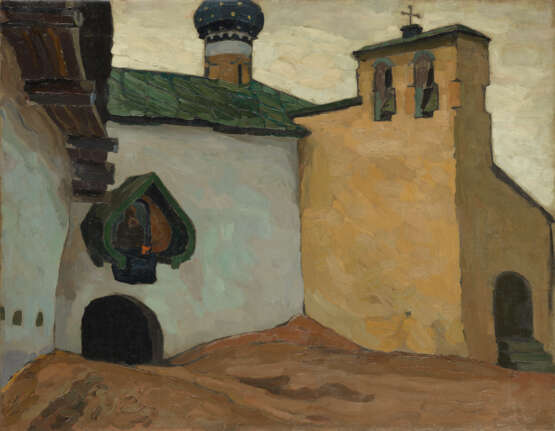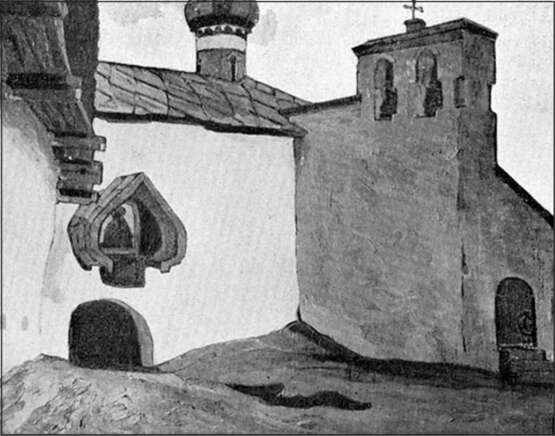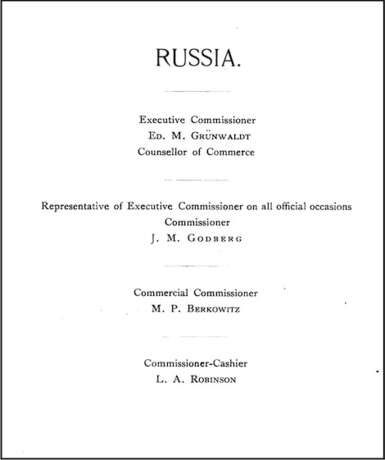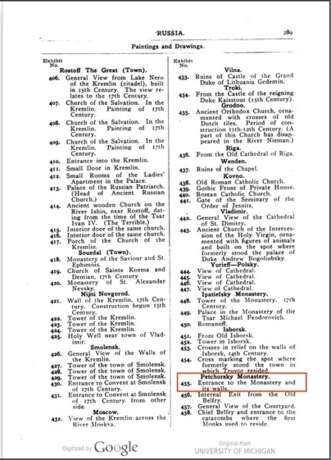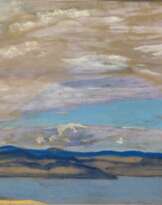ID 412528
Lot 36 | Pechory – Entrance to the Monastery
Estimate value
£ 400 000 – 600 000
Provenance: Private collection, Europe.
Authenticity of the work has been confirmed by the expert E. Yakovleva.
Authenticity of the work has also been confirmed by the expert O. Glebova.
Exhibited: Etyudy Russkoy Stariny, Imperatorskoe obshchestvo pooshchreniia khudozhestv, St Petersburg, 1903.
World's Fair, Louisiana Purchase Exposition, St Louis, 30 April–1 December 1904 (label on the reverse).
Literature: S. Makovsky, Svyatyni nashei stariny (Po povodu etudov N. Rerikha), Zhurnal dlya vsekh, No. 6, June 1904, p. 355, illustrated.
Exhibition catalogue, World's Fair, Louisiana Purchase Exposition, St. Louis, Little & Becker printing Co., 1904, p. 290, listed under No. 456.
Roseau, Nicolas Constantinovitch Roerich, L'Art Decoratif, No. 86, November 1905, p. 175, illustrated.
Nicholas Roerich’s Pechory. Entrance to the Monastery belongs to his celebrated “Architectural Series” (also known inter alia as “Sketches of Russian Antiquity”). The artist painted it during one of his summer study trips to the ancient Russian cities of central and north-western Russia in 1903–1904 – more precisely, during his stay in July 1903 at the Pskov-Pechory Monastery of the Dormition, one of the largest in Russia. The monastery has never been closed since its foundation in 1473, and survived intact during the 20th century. The artist found these places to be amazingly homely and tranquil and not to be compared with any place in the whole of central Russia.
Roerich undertook the 1903–1904 trip on behalf of several institutions simultaneously – the Committee of the Imperial Society for the Encouragement of the Arts, the Imperial Archaeological Society and the St Petersburg Trustee Committee for the Sisters of the Red Cross. During those years he developed a keen interest in the study of “Russian Antiquity” and was engrossed in the question of how to preserve historical and cultural monuments. Roerich saw the main purpose of his trips as producing sketches that could convey a vivid, fresh artistic impression of the places he visited, and to help record the archaeological features of any particular area. The sketches were mostly produced as oil paintings on plywood or canvas.
During his summer trip in 1903, the artist visited a total of 40 towns and cities, stretching from Kazan to Lithuania. Throughout the journey, he was accompanied by his wife, Helena, whose task it was to photograph buildings of architectural interest and the surrounding area. She took 500 photographs, while the artist himself made 71 painted sketches, nine of them views of the Pechory Monastery, including the picture now presented for auction. Compositional comparison of the work with the photographs that Helena Roerich took of the part of the monastery shown suggests that the sketch was created both from life and from the photographs taken on the spot.
Following the Roerichs’ 1903 summer trip, the Committee of the Imperial Society for the Encouragement of the Arts decided to mount an exhibition of the sketches at its headquarters to introduce the public to the buildings inherited from Russia’s past. The work now offered for auction also formed part of that display. At the beginning of 1904, the exhibition was visited by Emperor Nicholas II, who even wished to see the collection of Nicholas Roerich’s sketches placed in the Russian Museum. Unfortunately, the works were never transferred to the museum because of the war with Japan, which began shortly afterwards.
Having successfully staged the exhibition for the Committee of the Imperial Society for the Encouragement of the Arts, Roerich planned to move it to Paris and London, but these plans were never realised because, in Spring 1904, he took part in a larger project: the St. Louis World’s Fair. Roerich sent more than seventy works to the USA, including Pechory – Entrance to the Monastery. The outcome of the exhibition was that most of the works, including the one now presented at the auction, were sold and remained in the United States. The return and appearance at auction of one of the best pictures in the “Architectural Series” – a painting that was acclaimed immediately after its creation – is an undeniably important cultural event.
The present lot as illustrated in Zhurnal dlya vsekh
The present lot as listed in the exhibition catalogue
| Address of auction |
MacDougall Arts Ltd. 33 St James’s Square SW1Y 4JS London United Kingdom | ||||||||||||||
|---|---|---|---|---|---|---|---|---|---|---|---|---|---|---|---|
| Preview |
| ||||||||||||||
| Phone | +44 20 7389 8160 | ||||||||||||||
| Phone | +7 495 799 4683 | ||||||||||||||
| Fax | +44 (0) 20 7389 8170 | ||||||||||||||
| Buyer Premium | 27 % | ||||||||||||||
| Conditions of purchase | Conditions of purchase | ||||||||||||||
| Business hours | Business hours
|
